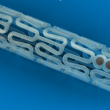Although there are 4 approved bioresorbable scaffolds (BRS) in Europe, experts suggest that current drug-eluting stents (DES) are the best option for coronary angioplasty. These new guidelines jointly published by the European Society of Cardiology (ESC) and the Association of Percutaneous Cardiovascular Interventions (EAPCI) are an update on the use of BRS in clinical practice...
Very Late Thrombosis in Bioresorbable Scaffolds
The presence of a metallic device interrupts normal laminar flow and creates an artery environment that favors thrombosis, leaving the vessel vulnerable to very late thrombosis. Dual antiplatelet therapy, a better implantation technique, and several improvements in new drug-eluting stents (DES) (thinner struts, and higher polymer stability and biocompatibility) have lowered significantly the incidence of...
Polymer-Free DES Also Show Efficacy in Anticoagulated Patients with High Risk for Bleeding
Patients who receive chronic anticoagulation therapy and then undergo angioplasty are frequently discharged on a triple anti-thrombotic scheme that usually includes aspirin, clopidogrel, and warfarin. The optimal duration of this indication remains unclear, particularly for patients at high bleeding risk. According to expert consensus, patients receiving chronic anticoagulation may receive from 1 to 12 months of dual...
Should We Begin to Use IVUS in CTO?
Courtesy of Dr. Carlos Fava. Currently, chronic total occlusions (CTO) are one of the obstacles that coronary angioplasties must overcome, particularly with the development of drug-eluting stents (DES) and new devices and strategies for these challenging lesions. However, there is little information on the safety, efficacy, and real clinical benefit of implanting stents of over 60 mm (known as full metal jackets, FMJ)....
Different Techniques for the Improvement of Outcomes in Intermittent Claudication
Peripheral vascular diseases affect over 20% of the population and can affect up to 30% of people with cardiovascular risk factors. The most important treatment points include modification of risk factors, exercise, optimal medical treatment, and timely revascularization. Given its lower risk of peri-procedural complications (when compared to surgery), endovascular therapy is generally the first...
Clinical Significance of Collaterals in Chronic Total Occlusions
Collateral circulation develops during the gradual progression of coronary occlusions in order to replace the original artery and supply blood to areas jeopardized by ischemia. However, the relevance of collaterals has remained controversial for many years. Several works have suggested a rapid regression of collaterals after rechanneling of chronic total coronary occlusions, which could render...
MRS vs. DES: Which one is associated with better long-term quality of life?
The SYNTAX (Synergy Between Percutaneous Coronary Intervention With Taxus and Cardiac Surgery) trial, which included patients with 3-vessel or left main coronary artery lesions, showed that myocardial revascularization surgery (MRS) turned out to be superior to angioplasty with drug-eluting stents (DES), mainly due to differences in acute myocardial infarction and repeat revascularization. Up to this work, patient sensations (which can be...
Post DES Dual Antiplatelet Therapy Still under Debate
The NIPPON trial (Nobori Dual Antiplatelet Therapy as Appropriate Duration) was a randomized study comparing a short dual antiplatelet therapy scheme (6 months) vs. a prolonged scheme (18 months) in patients receiving the Nobori drug eluting stent (Terumo, Tokyo, Japan) with a biodegradable abluminal polymer. It included 3,773 patients with chronic stable angina or acute coronary...
Glycemic control and risk of repeat revascularization
The association between glycemic control after coronary angioplasty and outcomes of the latter is controversial in many studies. We have come to think that the risk lies in suffering from diabetes, as if it was an unmodifiable factor. We have also come to believe that glycemic control can impact microvascular complications while it cannot do...
New generation DES present better results in vein grafts than older DES and BMS
There is little information comparing contemporary drug eluting stents (DES) against bare metal stents (BMS), for PCI in saphenous vein grafts in patients receiving (CABG). This study aimed to assess clinical outcomes after PCI in saphenous vein grafts in patients receiving BMS, first generation DES, and new generation DES between 2006 and 2013. The study...









